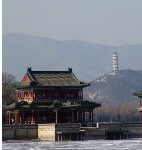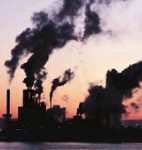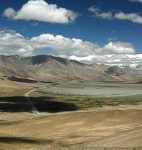Green development is the inevitable path
The traditional development strategies of industrialised countries all present two distinct features whether in Europe, the United States or Japan, despite their differing national and development conditions. One is that high-speed growth is sustained by high consumption of resources (especially non-renewable resources); the other is that the high-speed growth is stimulated by high consumption of the means of subsistence. We call this a traditional development model. In view of China’s conditions, it is impossible for China to realise modernisation by following the traditional model. The six principal reasons are:
1. When Europe, the United States and Japan launched industrialisation, they took an active part in international trade and linked themselves with the world market, accumulating industrial capital and opening up the international market through war and colonisation. They relied on the two wheels of industrialisation and international trade to effect economic take-off. China, however, had endured a hundred years of suffering before opening its doors and by then the international market had long been divided up. Its export product mix, principally primary goods, puts it in a very unfavourable position.
2. China’s industrialisation has come very late for China and the initial level is low, with a large gap to bridge with industrialised countries in production technology, development and resource use. Although it enjoys advantages as a later-comer, there are many obstacles.
3. China’s per capita resources were less than a fraction of those of Europe and the United States. It cannot realise modernisation at the cost of high consumption of resources and the means of subsistence.
4. China is a very populous country.
5. It is impossible for China to realise past models of capital accumulation by waging war and plundering resources from other countries, as the industrialised economies did. It must rely on internal reform and development.
6. The limitations of realising economic growth by following the traditional model are increasingly evident.
It is therefore imperative for China to follow a different development strategy. It should follow the non-traditional model best suited to Chinese national conditions, that is, it must establish a less resource-consuming production system and a living system with a proper level of consumption, an economic system with a sustained and stable growth and steadily rising economic efficiency, a social system that ensures social benefit and social equity, an applied technology system with constant innovation, fully absorbing new technologies, new processes and new methods, an international economic system that has close ties with the world market and a system with a rational development and utilisation of resources, that prevents pollution and protects the ecological balance. When we said that “a cat is good, white or black, so long as it can catch mice”, we meant that we can adopt whatever means to ensure economic growth and improve the living standards of the people. The colour of the cat is not important. But our development over the past 20 years is in fact “black development” or “black cat development,” to be more specific. It is characterised by high capital input, low output efficiency, high resource consumption and high pollution. It has sharpened the contradictions between population and resources and between development and environment. Now, the “colour of the cat” has become important. We have to turn “black cat” into “green cat”, shifting from black development to green development.
The UNDP’s “China Human Development Report 2002 — Making Green Development a Choice” for the first time advanced the idea that China should choose a green development path quite different from the “growth priority” traditional development model that has prevailed for years. The traditional model means “pollution first and control second” and “getting rich first, clearing up later.” It is a very dangerous path that would lead to a steady worsening of the environment and extremely uneven development, victimising the poor population. Green development stresses unified and harmonious development of the economy and environment, a positive path of people-centered sustainable development. It is possible for China not to repeat the high resource consumption and high pollution discharge process adopted by many western countries and go straight to the stage of “green development”. It is not necessary to wait for a fairly high income to be achieved to implement the “green development” strategy. The core of 21st century world development is human development, which has “green development” as its key theme. China has to shift from the traditional “black development” to “green development”. We hold that the green development model is identical to and reinforces the scientific development approach advanced by the new Chinese leadership.
China is in a good position to choose green development:
1. Economic restructuring of the economy, especially energy restructuring, is favorable for improving energy efficiency, lowering the unit output and pollution discharge and developing energy-efficient or non-energy intensive service and information industries.
2. Market-oriented reform has deregulated the energy price and introduced competition mechanisms, making it favorable for improving energy efficiency, reducing government subsidies to loss-making enterprises in production, transportation, storage and energy subsidies to urban residents.
3. Urban development has enabled more peasants to move to the cities, thus easing the pressure on the rural environment and using the scale effect of cities to lower production and consumption costs and reaping the benefits of efficiencies of scale in such urban public utilities as heating, water, gas, electricity and sewage treatment.
4. Technological innovation has made it possible to use all kinds of energy efficient and environmentally-friendly technologies, communications and transportation technologies, IT and biotechnology.
5. Economic globalisation has made it possible to utilise domestic and international resources and markets fully and to attract foreign direct investment. Open trading may provide the incentive to use new technologies and adopt clean technologies and green production. This indicates that developing countries can achieve fairly high economic growth and quality of environment before they attain the income level of developed countries.
6. An improved governance structure will help to raise the quality of government. For instance, it is necessary to introduce a mixed government model featuring both centralisation and decentralisation of power, to introduce the rule of law instead of the rule of man and establish a system complete with legislature, law enforcement and supervision; to establish a market-friendly environmental protection incentive system, reform the current environmental protection system to raise management efficiency and encourage public participation, disclose environmental protection information and public policies, to eliminate poverty and seek social justice and social equity.
Green development does not only represent a change in China’s development model but is also an important component of the strategy for the rise of the Chinese nation. In a word, we hold that China must opt for a green development model best suited to its national conditions, making full use of its rich human resources and effective and economical use of scarce natural resources, and import and develop knowledge resources in a big way. This is a non-traditional modernisation development model that conforms to Chinese national conditions. It is a people-centered scientific development approach; it is a new road to industrialisation; it is a path best suited to Chinese national conditions.
How to choose green development
Green development is a model that will sustain China’s rising strategy. China must shift its economic development model from traditional “black development” to “green development”. The general goal of the future green development should be established on a resource-efficient and environment-friendly society in which man and nature live in harmony. Specifically, it should include:
1. Effective control of population growth;
2. Raising the per capita income level and improve the equity index of income distribution and reducing poverty;
3. Increased efficiency of water use, effective water pollution control and the restoration of the deteriorating water ecology;
4. Strict protection of arable land and guaranteeing of the amount of arable land under cultivation;
5. A sharp rise in the utilisation rate of energy and a further lowering of the proportion of coal in the energy consumption structure;
6. Reduction of the CO2 discharge and effective control of air pollution in cities;
7. Further improvement of the ecological system, an increase in the forested area and expansion of the standing stock of timber;
8. Restoration of degraded grassland and expanded protection of water and soil from loss and erosion;
9. Strengthening the national safety net against natural disasters and establishing an emergency response and rescue system.
The green development choice requires green reform, which should serve as the cornerstone and institutional foundation for green development. By green reform, we mean to enable people to “enjoy more equally the benefits brought about by economic reform based on more active environmental policy and social partnership”. In other words, it is based on the market and equity principle and on good governance and effective management. The UNDP has put forward four recommendations:
1. To take advantage of the market mechanism to put forward integrated environmental and economic policies;
2. To establish a cooperative and interactive mechanism between government and the society at large to take common action to protect the environment. This could be realised by institutional innovation;
3. To develop green industries and green consumption;
4. To take the environment into full account in technical innovation.
China can make the green development choice while income levels are fairly low and it can adopt innovative low-cost strategies to limit pollution and sharply lower pollution density. China must introduce green reform and develop green industries and consumption by making full use of international resources and market mechanisms in partnership with the public, promote environment-friendly technical innovation, make extensive use of clean production technology and develop the recycling economy. The future of China’s “green development” has to experience the following process of transition:
1. Transition from “black cities” to “green cities”. It is necessary to clean the city environment, with emphasis on the control of water and air pollution and the harmless disposal of refuse. Different types of cities should have clear and different pollution discharge standards and a deadline for attaining the prescribed environmental standards. It is necessary to levy pollution tax when the time is ripe as a local surcharge. Cities must be encouraged to use clean coal technology and high-sulphur coal must be banned, the rate of centralised heat supply capacity and the use of fuel gas should be raised. Compulsory harmless disposal of city refuse and refuse classification must be imposed within a prescribed time limit.
2. Transition from “black energy” to “green energy”. It is imperative to make full use of both domestic and international energy, technology and markets by increasing the import of energy, especially clean energy, energy-efficient technology and environmental protection technology. We must develop hydropower and reduce the demand and use of coal, import natural gas and LNG to replace coal, raise the utilisation rate and penetration rate of natural gas, introduce a zero-VAT policy to encourage the use of solar energy, wind energy, tidal wave energy and other new forms of energy.
3. Transition from “black industry” to “green industry”. China should restructure its industry and actively develop labor-intensive and environment-friendly industries and services. It should continue to shut down backward, inefficient and polluting small enterprises and eliminate backward production capacities to optimise the industrial structure. Taxation, environment certification, environmental protection marks and other market means will encourage enterprises to adopt clean production technology. Foreign investors, foreign capital enterprises and private capital should be encouraged to invest in environmental pollution control and ecological restoration.
4. Transition from “black agriculture” to “green agriculture”. While consolidating ecological restoration achievements, China should emphasise major areas of ecological deterioration and, in line with the functions of different ecological systems, develop diversified and plural agriculture, forestry, horticulture, animal husbandry, breeding and aquatic industry. We should develop green food, green plants, green medicine and other high demand pollution-free agricultural products with high added value.
5. Transition from “black trade” to “green trade”. The government should support domestic enterprises to research and develop green products, actively promote green product certification according to international standards and advocate green consumption. The export of agricultural products, processed agricultural products and high-tech products that meet international standards and enjoy a competitive edge internationally should be developed. The country should open its environmental protection market and actively encourage multinational corporations to invest in energy and environmental protection industries to make full use of mature foreign pollution control technologies. China should play an active part in the handling of international environmental affairs and pursue bilateral or multi-lateral cooperation in environmental protection.
China must be firm in following the path of green development and make great efforts to bring about the shift in growth model so as to realise a well-off society, with man and nature living in harmony. The path of modernisation taken by China will be not only a “peaceful rise” but a “rise in green development”. China’s contribution to global development will be a “green contribution”.
1. Angus Maddison, The World Economy: A Millennial Perspective, OECD: Paris, 2001
2. ARUNDHATI KUNTE, KIRK HAMITON, JOHN DIXON AND MICHAEL CLEMENS, 1998, Estimating National Wealth: Methodology and Results[R]. January, The Environment Department, The World Bank.
3. FANKHAUSER,S ,1995 ,Valuing Climate Change :the Economics of the Greenhouse[M]. London: Earth scan.
4. KIRK HAMILTON and MICHAEL CLEMENS, 1998, Genuine Savings Rates in Developing Countries[M]. August. The Environment Department, The World Bank.
5. SACHS, J. and WARNER, 1995, Natural Resource Abundance and Economic Growth, Development Discussion Paper No. 517a, [M] Harvard Institute for International Development, Harvard University.
6. World Bank, 1997, Expanding the Measure of Wealth: Indicators of Environmentally Sustainable Development[R]. The Environment Department, The World Bank.
Hu Angang is Professor of Public Policy & Management at Tsinghua University and Director of the influential policy think tank, the Center for China Studies, Chinese Academy of Sciences/Tsinghua University. He did his post-doctoral research at Yale University and was a visiting professor at Harvard University and Keio University, Japan. Professor Hu has published widely on economic development and policy, and his writings are very influential in China’s public policy arena. This article was written in January 2001. Recommended by Premier Zhu Rongji, the article was carried in the internal “Reference Economic Information” of the State Council, it was then published in the Gazette of Beijing University (Philosophy and Social Science), No.4, 2001.



